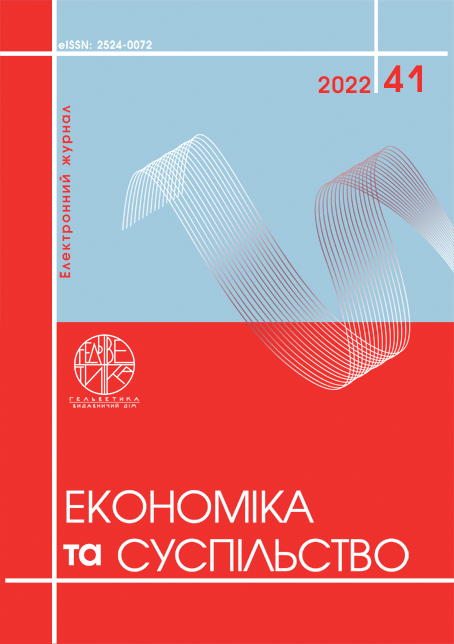ЕВОЛЮЦІЯ ТЕОРЕТИЧНИХ ПІДХОДІВ ДО ВИВЧЕННЯ ГІСТЕРЕЗИСУ ДОЛАРИЗАЦІЇ
Анотація
У статті узагальнено основні теоретичні підходи до вивчення явища гістерезису (або ефекту храповика) доларизації та заміщення валют в наукових працях протягом 1989-2021 років. На основі аналізу емпіричних досліджень доларизації у країнах Латинської Америки, перехідних економік та країн, що розвиваються, зроблено висновки щодо основних пояснень гістерезису доларизації та заміщення валют. У багатьох працях наголошується на існуванні двох рівноважних станів доларизації – низького (близько 15%) і високого (близько 75%). Основними причинами збереження високого рівня доларизації можуть бути тривалі негативні очікування економічних суб’єктів та мережеві зовнішні ефекти (мережеві екстерналії), що полягають у виборі економічними суб’єктами саме іноземних валют транзакцій, оскільки іноземні валюти вже перебувають у широкому використанні. Для української економіки ця проблема також актуальна, тому доцільним є подальше вивчення гістерезису доларизації в Україні.
Посилання
Melvin, Michael and Fenske, Kurt. (1992). Dollarization and Monetary Reform: Evidence from the Cochabamba Region of Bolivia. Revista de Análisis Económico – Economic Analysis Review, Vol 7, No 1, pp. 125-138.
Melvin, Michael and Ladman, Jerry. (1991). Coca Dollars and the Dollarization of South America. Journal of Money, Credit and Banking, Vol. 23, No. 4, pp. 752-763.
Calvo, Guillermo and Végh, Carlos A. (1992). Currency Substitution in Developing Countries: An Introduction. IMF Working Paper No. 92/40.
Dornbusch, Rudiger and Reynoso, Alejandro. (1989). Financial Factors in Economic Development. NBER Working Paper No. 2889.
Dornbusch, Rudiger, Sturzenegger, Federico and Wolf, Holger. (1990). Extreme Inflation: Dynamics and Stabilization. Brooking Papers on Economic Activity, 1990, pp. 2-84.
Guidotti, Pablo and Rodriguez, Carlos. (1992). Dollarization in Latin America: Gresham’s Law in Reverse. IMF Staff Papers, Vol. 39, No. 3, pp. 518-544.
Uribe, Martin. (1997). Hysteresis in a simple model of currency substitution. Journal of Monetary Economics, Elsevier, vol. 40 (1), pp. 185-202.
Peiers, Bettina and Wrase, Jeffrey M. (1997). Dollarization hysteresis and network externalities: theory and evidence from an informal Bolivian credit market. Working Papers 97-21. Federal Reserve Bank of Philadelphia.
Honohan, Patrick and Shi, Anging. (2001). Deposit dollarization and the financial sector in emerging economies. Policy Research Working Paper Series 2748, The World Bank.
Havrylyshyn, Oleh and Beddies, Christian H. (2003). Dollarisation in the Former Soviet Union: from Hysteria to Hysteresis. Comparative Economic Studies, Palgrave Macmillan; Association for Comparative Economic Studies, vol. 45(3), pp. 329-357.
Shinkevich, Andrei and Oomes, Nienke. (2002). Dollarization Hysteresis in Russia. Economics Education and Research Consortium (EERC). January 2002.
Oomes, Nienke. (2003). Network Externalities and Dollarization Hysteresis: The Case of Russia. IMF Working Paper No. 03/96. Washington: International Monetary Fund, .
Tellería, Bernardo X. Fernández. (2007). Dollarization hysteresis, network externalities and the “past legacy” effect: the case of Bolivia. Monetaria, Centro de Estudios Monetarios Latinoamericanos, CEMLA, vol. 0(2), pp. 167-217.
Krupkina, Anna and Ponomarenko, Alexey. (2015). Deposit dollarization in emerging markets: modelling the hysteresis effect. BOFIT Discussion Papers 32/2015, Bank of Finland, Institute for Economies in Transition.
Burova, Anna; Kozlovtseva, Irina; Makhankova, Natalia and Morozov, Alexander. (2021). Dollarization, Financial Stability Risks and Monetary Policy Implementation: Exploring the Nexus. Ensayos Económicos, Central Bank of Argentina, Economic Research Department, vol. 1(77), pp. 50-71.
Us, Vuslat. (2003). Analyzing the Persistence of Currency Substitution Using a Ratchet Variable : The Turkish Case. Emerging Markets Finance and Trade, 39:4, 58-81.
Irfan, Civcir. (2010). The Long-Run Determinants of Dollarization in Turkey. EcoMod2002 330800019.
Şıklar, İlyas; Karagöl, Veysel and Şahin, Suzan. (2017). Is There Any Meaningful Ratchet Effect in the Process of Currency Substitution? Evidence from Turkey. Business and Economic Research, Macrothink Institute, vol. 7(2), pp. 146-162.
Hijazeen, Issa and Al-Assaf, Ali. (2018). Dollarization in Jordan. International Journal of Economics and Financial Issues, Econjournals, vol. 8(2), pp. 14-24.
Menon, Jayant. (2008). Cambodia's Persistent Dollarization: Causes and Policy Options. Working Papers on Regional Economic Integration 19, Asian Development Bank.
Bawa, Sani; Omotosho, Babatunde and Doguwa, Sani. (2015). Ratchet Effects in Currency Substitution: An Application to Nigeria. CBN Journal of Applied Statistics. Volume 6.
Mongardini, Joannes and Mueller, Johannes. (1999). Ratchet Effects in Currency Substitution: An Application to the Kyrgyz Republic. IMF Working Paper 99/102.
Freitas, Miguel Lebre de. (2003). Revisiting Dollarisation Hysteresis: Evidence from Bolivia, Turkey and Indonesia. NIPE Working Papers 12/2003, NIPE – Universidade do Minho.
Valev, Neven T. (2010). The hysteresis of currency substitution: Currency risk vs. network externalities. Journal of International Money and Finance, Elsevier, vol. 29(2), pp. 224-235.
Samreth, Sovannroeun. (2011). An Empirical Study on the Hysteresis of Currency Substitution in Cambodia. Journal of Asian Economics, Vol. 22, No. 6, pp. 518-527.
Idrisov, Georgy and Freinkman, Lev. (2009). Modeling the Currency Structure of Bank Deposits: Does the Ratchet Effect Matter? Working Papers 0005, Gaidar Institute for Economic Policy.


